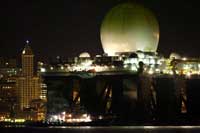The SBX-1 , the Sea Based X-Band Radar 1, looks like something out of science fiction. It recently arrived at Vigor Shipyard on Seattle’s Harbor Island for three months of maintenance and upgrading.
The SBX-1 is a huge white dome with a half dozen or so smaller domes ontop of a modified MODU, a Mobile Offshore Drilling unit, on which high tech radar arrays have replaced the drilling rig. It is 240 feet wide, 390 feet long, and 280 feet high from its keel to the top of the radar dome (radome) and can cross an ocean under its own power at eight knots.
Massive radar could track baseball from across a continent
The U.S. Missile Defense Agency’s Boeing-built Sea-Based X-band Radar, which pulled into Seattle late Tuesday, can track tiny objects from across a continent and send targeting information to a laser.
“You could put the SBX in the Chessapeake Bay and it could track something the size of a baseball hit outside here from Safeco Field, provided it could get over the curvature of the earth,” Army Col. Mark Arn, the Missile Defense Agency’s project manager for the X-band sensors, said Wednesday.
Of course, the billion-dollar radar is designed to track missiles, not baseballs. It is scheduled to spend about 90 days at Seattle’s Vigor Shipyards for maintenance and upgrades, including adding the ability to plug into shore power, rather than having to use its six diesel generators while in port, and adding redundant power and radar systems, because the radar is spending more time at sea — more than 300 days in one year — than originally expected, Arn said.
Vigor is one of only a couple of ship yards on the West Coast capable of handlign the radar, and the one that fit its schedule, Arn said. Boeing — the prime contractor on the Missile Defense Agency’s Ground-based Midcourse Defense program — is performing the work, with Vigor as a subcontractor, under a $27.1 million contract.
The missile-tracking radar, enclosed in the big white dome is octagonal and 85 feet across. The smaller domes are for such side tasks as satellite communications and weather tracking.
Thanks to Phil Leon for passing the story along.

